
What historians broadly agree on
- Christianity began as a 1st-century Jewish movement centered on Jesus of Nazareth, crucified under Pontius Pilate (Roman prefect of Judea) during Tiberius’s reign. The best early Christian sources are Paul’s letters (c. 50–60 CE), our earliest surviving Christian writings. (Encyclopedia Britannica)
- The Gospels were composed a bit later: Mark ~70 CE; Matthew/Luke ~80–90 CE; John ~90–100 CE (ranges vary by scholar). (Encyclopedia Britannica)
- There are non-Christian references to Jesus/Christians within decades: Tacitus (Annals 15.44, c. 116 CE) on Nero’s punishment of Christians and Jesus’ execution; Pliny the Younger (c. 112 CE) on Roman handling of Christians in Bithynia; Josephus (93 CE) mentions Jesus and “James the brother of Jesus,” with the key passage generally seen as partially interpolated but based on an authentic core. (Penelope, Georgetown Faculty, vroma.org, Brill)
- Early material evidence & manuscripts: the Dura-Europos house-church (Syria, 3rd c.), often called the earliest known Christian church building; the Rylands papyrus P52 (a few verses of John, often dated to the 2nd c.); and the Codex Sinaiticus (oldest complete NT, 4th c.). A 1st-century “Pilate Stone” from Caesarea attests Pilate’s historicity. (Yale University Art Gallery, codexsinaiticus.org, British Library Blogs)
Matters such as Jesus’s divinity or the Resurrection are theological claims. Historians can document the belief in them very early; their truth is a question of faith.

From sect to church (1st–4th centuries)
- Jerusalem → the Mediterranean: The movement quickly included non-Jews (Gentiles), a shift reflected already in the NT and early missions described in Acts and Paul’s letters. (Encyclopedia Britannica)
- Persecution & legalization: Sporadic local persecutions are attested (e.g., Nero’s Rome). In 313 the Edict of Milan granted Christians legal toleration; in 380 the Edict of Thessalonica made Nicene Christianity the empire’s official faith. (Penelope, Encyclopedia Britannica)
- Defining doctrine: The Council of Nicaea (325) produced the Nicene Creed and condemned Arianism; later councils refined Christology. (Encyclopedia Britannica)
- The canon: Lists of authoritative Christian books emerge by the late 2nd c. (e.g., Muratorian Fragment). By the 4th c., writers like Eusebius describe widely accepted vs. disputed books, and the 27-book NT is attested (e.g., Athanasius, 367). (Encyclopedia Britannica, New Advent)
- First Christian states: Armenia (traditionally 301–314) and Aksum/Ethiopia (4th c.) officially adopt Christianity. (Encyclopedia Britannica)
Schisms, reforms, and global spread
- East–West Schism (1054) split communion between Rome (Catholic) and Constantinople (Orthodox). (Encyclopedia Britannica)
- Oriental Orthodox churches (Coptic, Armenian, Syriac, Ethiopian/Eritrean, Malankara) had separated earlier over Chalcedon (451); modern dialogues acknowledge long-standing misunderstandings. (Encyclopedia Britannica)
- Protestant Reformation (from 1517) diversified Western Christianity (Luther, Calvin, Anglican traditions); Catholic Council of Trent (1545–63) re-affirmed doctrine and reforms. (Encyclopedia Britannica, Medium)
- Missionary expansion (16th–19th c.) carried Christianity worldwide, creating enduring churches across the Americas, Africa, and Asia. (See also Armenia/Aksum above and later Global South growth.) (Pew Research Center)
Christianity today (numbers & where it’s growing)
- Globally there are roughly 2.6–2.7 billion Christians (~31% of humanity), with the Global South now the center of gravity. Africa has the largest regional Christian population and continues to grow rapidly. (Pew Research Center)
- By tradition, Catholics remain the largest single family (Vatican figures), alongside large Protestant, Independent, Pentecostal/Charismatic, Anglican, and Orthodox communities; Renewalist (Pentecostal/Charismatic) movements constitute ~25–30% of Christians and are a major driver of growth in Africa, Latin America and parts of Asia. (Wikipedia, Pew Research Center)
Key primary evidence (a sampler you can check)
- Tacitus, Annals 15.44 (c. 116 CE): notes Nero’s punishment of Christians and that “Christus” was executed under Pilate. (Loeb/MIT text) (Penelope)
- Pliny-Trajan correspondence (c. 112 CE): Roman governor describes Christian practices and asks how to prosecute. (Georgetown/Attalus translations) (Georgetown Faculty, Attalus)
- Josephus, Antiquities 18 & 20 (93 CE): references to Jesus/James; majority view sees an authentic core with later Christian additions in 18.3.3. (Surveyed in modern scholarship) (Early Christian Writings, Brill)
- Manuscripts & archaeology: Dura-Europos house-church (Yale Art Gallery); Rylands P52 fragment (2nd c.); Codex Sinaiticus (oldest complete NT). (Yale University Art Gallery, codexsinaiticus.org)
Timeline
- c. 30: Jesus executed in Jerusalem. Early Jerusalem community forms. (Encyclopedia Britannica)
- 50s: Paul’s letters. (Encyclopedia Britannica)
- 70–100: Gospels composed. (Encyclopedia Britannica)
- 112–116: Pliny & Tacitus on Christians. (Georgetown Faculty, Penelope)
- 313/325/380: Edict of Milan; Council of Nicaea; Edict of Thessalonica. (Encyclopedia Britannica)
- 451/1054: Chalcedon; East–West Schism. (Encyclopedia Britannica)
- 1517ff.: Protestant Reformation; Catholic/Protestant missionary expansion. (Encyclopedia Britannica)
- 20th–21st c.: Ecumenical dialogues; Vatican II; rapid Global-South and Pentecostal growth. (Wikipedia, Pew Research Center)
Bottom line
Christianity’s origin is well documented in mid-1st-century texts (Paul), late-1st-century Gospels, non-Christian Roman/Jewish notices within decades, and early manuscripts/archaeology. Over two millennia it developed through councils, schisms, and reforms, and today it is a global, highly diverse family of traditions with its demographic heart in the Global South. (Encyclopedia Britannica, Penelope, Yale University Art Gallery, Pew Research Center)


